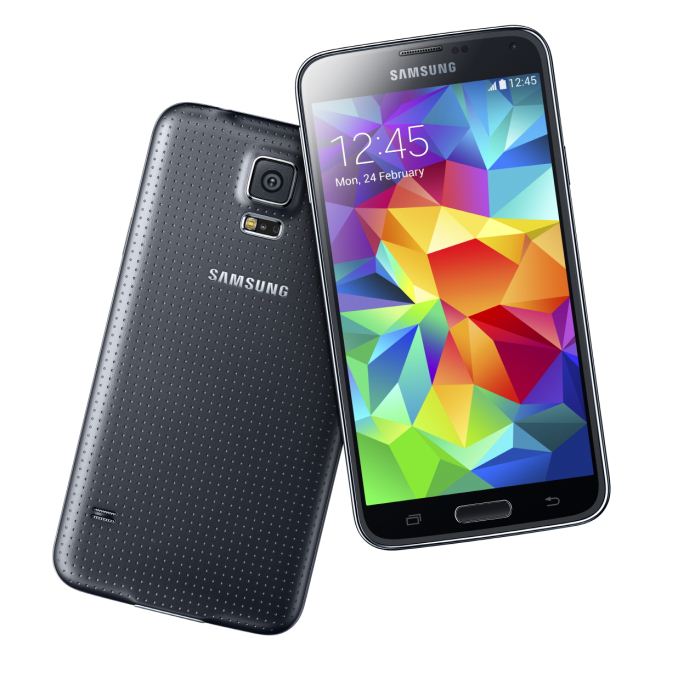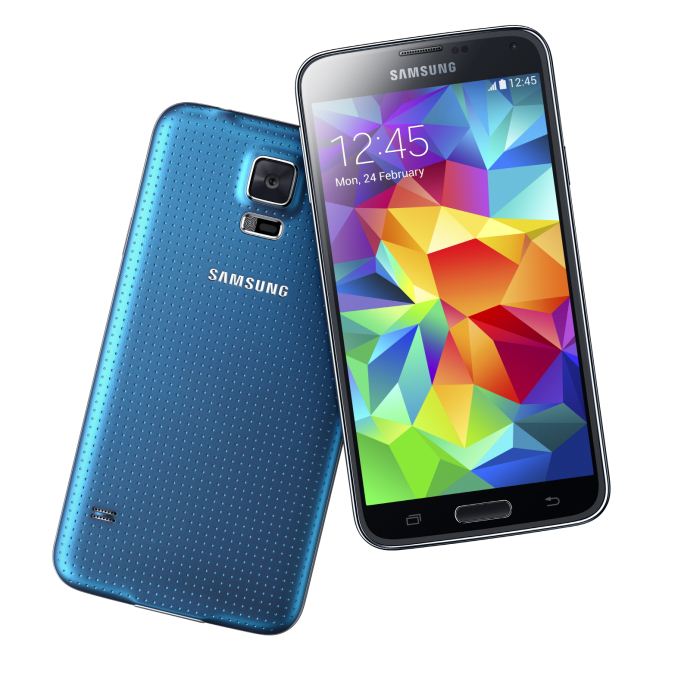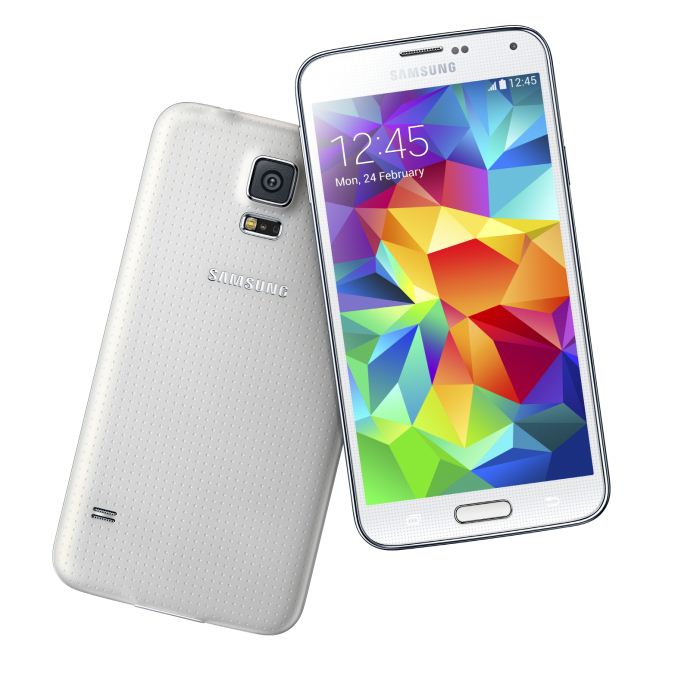Samsung Announces Galaxy S5: Initial Thoughts
by Joshua Ho on February 24, 2014 2:04 PM EST- Posted in
- Trade Shows
- Samsung
- Galaxy
- Smartphones
- Mobile
- MWC 2014

Every year Samsung launches a new Galaxy S flagship smartphone, and as always, Samsung puts the best platform that can be bought in their devices. The Galaxy S5 is no exception, as the MSM8974AC, or Snapdragon 801, powers the Galaxy S5. The 8974AC is the 2.45 GHz bin of the MSM8974AB, a slightly massaged MSM8974 that first launched with the LG G2 and other devices in the summer of 2013. As a recap, the MSM8974AB increases the clock speed of the Hexagon DSP to 465 MHz from 320 MHz, and the LPDDR3 RAM clocks go from 800 MHz to 933 MHz. What really matters though, is that GPU goes from 450 MHz to 578 MHz from 8974 to 8974AC. I definitely have to point to Anand's piece on the Snapdragon 801 for anyone that wants to know more.
The other portion of the hardware story is the camera, which is probably one of the biggest areas for OEMs to distinguish themselves from the pack. Samsung seems to be playing it safe this year with a straight upgrade from 13MP to 16MP by increasing sensor size, and pixel size remains at 1.12 micron side edge length. It is notable that the camera sensor seems to be in a 16:9 aspect ratio, which would make it possible for both photos and videos to keep the same interface without odd reframing effects when going from photo preview to camcorder functionality. Optics are effectively unchanged from the Galaxy S5, as the focal length in 35mm equivalent remains at 31mm, the aperture remains at F/2.2. The one area where there could be a notable improvement is the promised ISOCELL technology, which physically separates pixels better to reduce quantum effects that can lead to lower image resolution and also increases dynamic range, although this will require testing to verify the claims made by Samsung. Samsung has also added 4K video recording for this phone and real time HDR to extend the dynamic range of the camera.
The Galaxy S5 has 2GB of RAM, also not too surprising given the 32-bit ARMv7 architecture of the 8974AC.
The display is a 1080p 5.1” panel, which makes this phone around the same size as the LG G2. Samsung has definitely improved AMOLED, but first impressions are unlikely to tell much when it comes to the quality of calibration and other characteristics of the device. In all likelihood, this will continue to use an RGBG pixel layout in order to improve aging characteristics as the various subpixels age at differing rates. I would expect max brightness to increase, although this may only show in very specific conditions such as extended sunlight exposure and low APL scenarios.
The industrial design seems to be an evolution of the Note 3, with a texture that looks similar to that of the Nexus 7 2012. However, whether the stippled texture will actually avoid the long-term issue of a slimy/oily feel is another question that will have to be answered after the hands-on. While we're still on the point of the hardware design, the Galaxy S5 is IP67 rated, which is why the microUSB 3.0 port has a cover for water and dust resistance.
The fingerprint sensor is a swipe-based one, and Brian has voiced displeasure over swipe sensors like those found in the One max. I personally think that there could be some issues with ergonomics, as Samsung places the home button very close to the edge of the phone, which would make it rather difficult to swipe correctly over the home button, especially if the device is being used with one hand.
As always, Samsung has included removable battery and a microSD slot for those that need such capabilities, although now that Samsung is following Google guidelines regarding read/write permissions, the utility of the microSD slot could be much less than previously expected. For the battery, things are noticeably different as Samsung has gone with a 3.85V chemistry compared to the 3.8V chemistry previously used by the Galaxy S4. With a battery capacity of 10.78 WHr, this means that it has 2800 mAh. For reference, the Galaxy S4 had a 9.88 WHr battery with 2600 mAh.
As always, Samsung has put TouchWiz on top of their build of Android that will ship with the Galaxy S5, and it mostly looks the same. There are definitely some new features though like My Magazine, which seems to be a way of presenting multiple sources of information using a scrollable list of tiles with images on them.
There might be a trend here in the paragraphs, and while some may see it as a tic, it’s probably more representative of the consistency that Samsung is bringing to the table. “As always” means that people know what to expect, and while it may not be nearly as exciting to the tech press, average people live and die by what’s relatively familiar, not what’s new and exciting. The addition of new features and consistent improvements to performance without compromise relative to the previous generation is definitely something to be applauded, and with review units, hopefully it will be possible to see how the GS5 stacks up against the competition.
At any rate, the phone will launch with blue, black, white, and gold colors. It launches April 11 in 150 countries.













127 Comments
View All Comments
darwinosx - Monday, February 24, 2014 - link
Exaclty. Very Microsoft like. Derivative and mediocre.JohanAnandtech - Tuesday, February 25, 2014 - link
I have to agree. I don't get that Samsung implements 16 MP camera, while the problem is not pixel count, but the fact that you have to be in almost ideal circumstances to shoot a good photo with these devices. The optics and sensors can not handle 8 MP but hey here is 16 MP.JoshHo - Tuesday, February 25, 2014 - link
That would give around 1.55 micron pixels, which would mean that the camera would effectively have the same sensitivity as the iPhone 5s' camera.paradox226 - Monday, February 24, 2014 - link
I like the direction Samsung is taking. I call it the Porsche approach, because that what Porsche has done over 50 years. You look at a modern Porsche you can still see the original design from 1963. Just because their subtle changes does not live up to all the hype does not mean that it worthless. If it isn't broke don't fix it. I would rather have faster hardware than a fancy look, since you can't upgrade the hardware and future updates can slow down a lot of phones. I just got 4.3 on my Note 2 and it has some problems. If you want my opinion they should skip metal and go with carbon fiber. It can be injection molded like plastic (Zoltech) and they can still have a replaceable battery; Which for me is a must. (I have had batteries die before and would hate to replace an entire device all because of a $40 battery.) Also it would take less time to produce than CNC Milling Aluminum. and be way cooler.Bob Todd - Monday, February 24, 2014 - link
Except the 911 design is thought to be sort of timeless and beautiful by many. Comparing the design language of the Galaxy line to that vehicle is absolutely laughable. You can argue function over form, but these are not "sexy" devices (which doesn't matter to many) so it's a pretty bad analogy.Bobs_Your_Uncle - Monday, February 24, 2014 - link
Maybe the 914?Bob Todd - Tuesday, February 25, 2014 - link
LOL. Definitely not a beauty, but I think it's still probably more interesting looking compared to its peers at the time than the Galaxy will be to theirs in 40 years. Maybe Samsung can shift around some design resources from their refrigerator group...paradox226 - Monday, February 24, 2014 - link
Not really, Every flagship needs its design identity. Right know the Galaxy line has its design and their is no real reason to change it. When the 911 first came out it wasn't considered to be a timeless design, but evolved into a timeless design. I like the overall design I and an glad that they are refining the features and not just all over the place with design.Bob Todd - Tuesday, February 25, 2014 - link
You're missing the point. Even 50 years later the original 911 is a pretty car.http://press.porsche.com/media/gallery2/v/photos/h...
It had a _good_ design from the beginning that they have been refining ever since. All gadgets have *a* design. That isn't any reason to stick with it over time. There is plenty of reason to change the design of the Galaxy line since that's the one part that is severely lacking. I'm not suggesting they get rid of expandable storage or removable batteries. But they could make a phone with all of the features of the existing line, AND make it damn good looking. 10 years from now the current iPhone/HTC One (or hell many of the Lumias) are still going to be good looking devices. There's no good technical reason preventing Samsung from joining that club, and I wish they would.
steven75 - Monday, February 24, 2014 - link
I don't think there's a company *more different* than Porsche.Porsche = Decades of small refinements to same vision with nothing that doesn't feel out of place.
Samsung = Throw everything at the wall without worrying if it makes sense or not and tick off spec check boxes based on what competitors do.